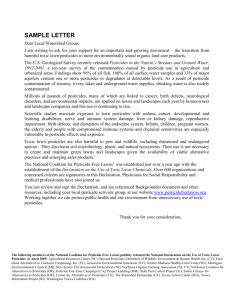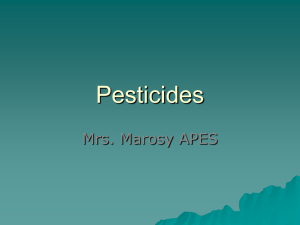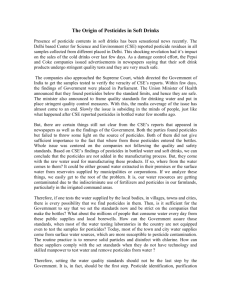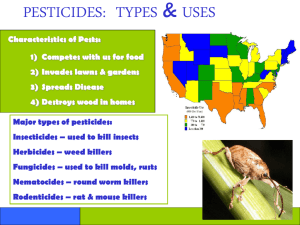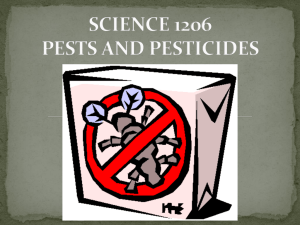Pesticides Outline - Weber State University
advertisement
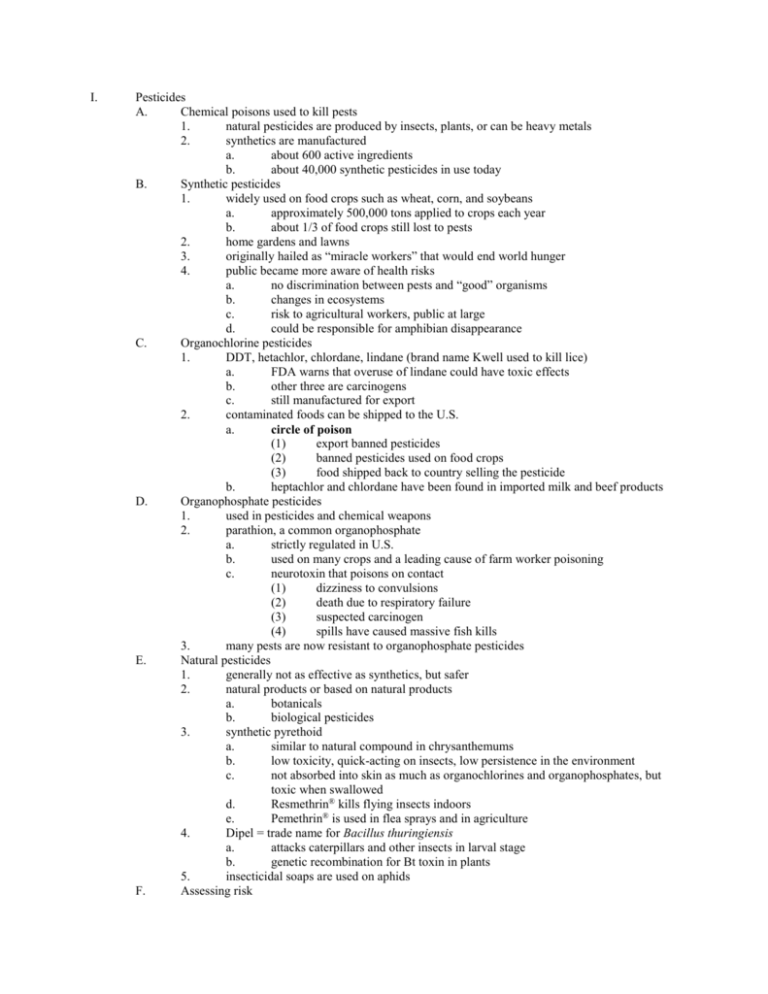
I. Pesticides A. Chemical poisons used to kill pests 1. natural pesticides are produced by insects, plants, or can be heavy metals 2. synthetics are manufactured a. about 600 active ingredients b. about 40,000 synthetic pesticides in use today B. Synthetic pesticides 1. widely used on food crops such as wheat, corn, and soybeans a. approximately 500,000 tons applied to crops each year b. about 1/3 of food crops still lost to pests 2. home gardens and lawns 3. originally hailed as “miracle workers” that would end world hunger 4. public became more aware of health risks a. no discrimination between pests and “good” organisms b. changes in ecosystems c. risk to agricultural workers, public at large d. could be responsible for amphibian disappearance C. Organochlorine pesticides 1. DDT, hetachlor, chlordane, lindane (brand name Kwell used to kill lice) a. FDA warns that overuse of lindane could have toxic effects b. other three are carcinogens c. still manufactured for export 2. contaminated foods can be shipped to the U.S. a. circle of poison (1) export banned pesticides (2) banned pesticides used on food crops (3) food shipped back to country selling the pesticide b. heptachlor and chlordane have been found in imported milk and beef products D. Organophosphate pesticides 1. used in pesticides and chemical weapons 2. parathion, a common organophosphate a. strictly regulated in U.S. b. used on many crops and a leading cause of farm worker poisoning c. neurotoxin that poisons on contact (1) dizziness to convulsions (2) death due to respiratory failure (3) suspected carcinogen (4) spills have caused massive fish kills 3. many pests are now resistant to organophosphate pesticides E. Natural pesticides 1. generally not as effective as synthetics, but safer 2. natural products or based on natural products a. botanicals b. biological pesticides 3. synthetic pyrethoid a. similar to natural compound in chrysanthemums b. low toxicity, quick-acting on insects, low persistence in the environment c. not absorbed into skin as much as organochlorines and organophosphates, but toxic when swallowed d. Resmethrin® kills flying insects indoors e. Pemethrin® is used in flea sprays and in agriculture 4. Dipel = trade name for Bacillus thuringiensis a. attacks caterpillars and other insects in larval stage b. genetic recombination for Bt toxin in plants 5. insecticidal soaps are used on aphids F. Assessing risk 1. 2. 3. G. H. I. identify potential health effects determine dose-response (LD50) assess exposure risk a. inhalation, absorption through skin ingestion b. food c. home/personal use d. pesticides in drinking water e. exposure at work 4. risk characterization (risk = toxicity x exposure) 5. low dose, long term effects have been ignored Problems with risk assessment 1. pesticide regulatory studies only assess single exposures to single active ingredients 2. pesticide testing is not done with children or other susceptible groups in mind 3. pesticide testing only studies certain kinds of human health risks a. acute poisoning b. cancer c. neurotoxic effects 4. pesticide testing is largely the responsibility of the manufacturers 5. federal law prohibits the advertising of pesticides as safe, even if used as directed 6. inert ingredients (may account for 99%) are not divulged to consumers, applicators, state agencies, or physicians a. everything but the active ingredient is allowed to be described as “inert,” and is protected as a trade secret b. canceled pesticides (DDT, chloroform) c. known carcinogens (benzene, toluene) d. industrial solvents (methylene chloride, trichloroethane) e. Toxic Substances Control Act substances (dimethylpthalate, methyl bromide) 7. following directions and professional practices does not eliminate an exposure risk a. long persistence times for synthetic pesticides b. accumulation in body tissues c. biological breakdown takes a long time d. degradation can produce even more toxic metabolites Lowering risk 1. wash fresh produce well a. peel and skin fruits if possible b. scrub vegetables thoroughly 2. store household pesticides in safe ways a. exposure at home from poor storage (under sink) b. during colder months, houses closed tight c. ingestion, especially by children 3. chronic exposure linked to increased risk of cancer, especially in children Accumulation 1. government report (CDC) due in early 2001 a. survey of levels of lead, pesticides, other undesirable substances in blood b. exposure through environment and diet 2. comparison with existing data to determine possibility of links a. cancer b. hormonal problems (1) child development (2) infertility 3. 25 compounds to be investigated a. heavy metals, including lead b. tobacco products c. organophosphate pesticides d. phthalates (used to soften plastics) e. dioxins f. J. PCBs (1) (2) (3) (4) manufacture of electrical components (industrial waste) slow to degrade in environment accumulates in fatty tissue manufacture banned in 1977 Chronic problems 1. data from recent laboratory tests, wildlife research, and accidental human exposure studies indicate that synthetic chemicals, including pesticides, can cause serious damage at extremely low levels a. bulk of pesticide research focuses on poisoning or carcinogenicity b. many chemicals, like hormones, can have profound effects at low concentrations 2. accumulation of synthetic pesticides in body tissues is virtually permanent a. men have an ever-increasing load of chemicals b. women can only lose it through breast milk or across the placenta to a developing fetus 3. pesticides can have reproductive or endocrine-disrupting effects a. mimic hormones b. bind to hormone receptors Pesticides Reported to Have Reproductive and Endocrine Disrupting Effects lindane carbaryl malthion methomyl dicofol methoxychlor mirex DDT oxychlordane parathion hetachlor synthetic pyrethroids chlordane dieldrin endosulfan toxaphene Possible Effects of Endocrine Disrupters infertility endometriosis breast cancer altered fetal/child development testicular cancer prostate enlargement low sperm count learning disorders 4. 5. 6. 7. Category endocrine disrupters cause birth defects, infertility, and learningdisabilities a. men in western world have 50% lower sperm counts than in 1938 b. reproductive system cancers (1) breast (2) testicular endocrine disrupters are transferred to the fetus a. affects fetal development b. affects children some evidence suggests a detrimental effect on the immune system a. immunotoxicity not tested b. immune systems of mammals are very similar population studies support lab studies showing immunotoxic effects a. indirect evidence for cancer types found in groups occupationally exposed to pesticides b. direct studies in former Soviet Union looking at populations in regions of heavy pesticide use c. direct studies of Canadian Inuits who ingest a high level of pesticides in their diet (1) Inuit children 30x more likely to contract meningitis (2) suffer chronic otitis (ear infections) at epidemic rates Categories of Acute Toxicity Signal Word Required on Label Oral Ld50 Dermal LD50 Inhalation LC50 mg/l Approximate Oral dose that can Kill an Average Person Mg/kg mg/kg DANGERI Highly toxic *[Poison! Skull Crossbones] From 0 to From 0 to 50 200 II Moderately WARNING! Toxic From 50 to 500 III Slightly Toxic CAUTION!! From 500 From 2000 to 5000 to 20,000 From 2.0 to 20 Over 1 ounce to 1 pint or 1 pound III Slightly Toxic CAUTION!! More than More than 5000 20,000 Greater than 20 From 0 to 0.2 A few drops to 1 teaspoon full [or a few drops on the skin] From 200 to From 0.2 to 2 Over 1 teaspoonful to 1 ounce 2000 Over 1 pint or 1 pound Toxicity Categories for Pesticides Hazard Indicators Oral LD50 I II Up to and including From 50 through 500 mg/kg 50 mg/kg. From 2.0 through 20 mg/l. Inhalation LC50: Up to and including III From 500 through 5,000 mg/kg. IV Greater than 5,000 mg/kg. From 20 through 200 mg/l. Greater than (a) Dust or mist 2.0 mg/l. Inhalation LC50: Up to and including From 200 through 2,000 p/m. (b) Gas or vapor 200 p/m. 200 mg/l. From 2,000 through 20,000 p/m. Greater than 20,000 p/m. From 2,000 through 20,000 mg/kg. Greater than 20,000 mg/kg. Dermal LD50 Up to and including From 200 through 2,000 mg/kg. 200 mg/kg. Eye effects No corneal opacity Irreversible corneal Corneal opacity reversible within 7 No irritation reversible within opacity at 7 days. days or irritation persisting for 7 days. irritation. 7 days. Skin irritation Severe irritation or damage at 72 Moderate irritation at 72 hours. hours. Mild or slight irritation at No irritation 72 hours. at 72 hours.



